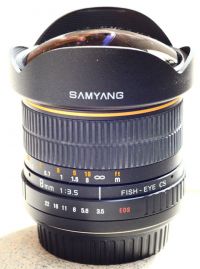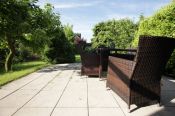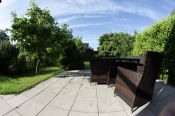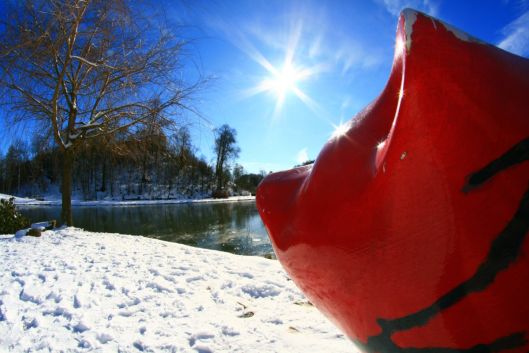Support
You can support this site without any cost or disadvantage at all by clicking this link to Amazon or the one on the left before buying anything – be it underpants, a cupboard, a TV, a pen, a lens or a camera. Amazon is the only shop worldwide, I’m really satisfied with to a 100%, so I have no caveats advertising them. Of course, you can also directly donate a small amount of money, e.g. the amount you would have spent for a magazine, with the button on the left.

Samyang 8mm 1:3.5 CS UMC Fisheye
A fully manual Korean fullframe-fisheye for APS-C: "Fullframe" means, that it covers the complete image-frame, as opposed to "circular" fisheyes, which make a round image (circle) in the middle of the frame.
This lens is very good mechanically and the best fisheye I have ever seen, used or heard of, at any price, from any manufacturer. It does not only have extraordinary optical quality, it is also the only fisheye on the market with a (nearly) stereoscopic projection, which I find the most pleasing method by far and really love. I suggest reading about these differences on wikipedia, but I'll try to give you a short overview later, or see "Fisheye, distortion and projection-methods".
Sadly, there is no version for "fullframe" sensors and the mFT - version, which has a huge size-advantage, doesn't use the same projection method. So this lens is the reason, why I will probably always own an APS-C camera or maybe even buy an EOS M with adapter one day.
The purely mechanical usage is not the slightest problem: Depth of field is so huge, that manual focussing doesn't have to be precise, everything is in focus: Just adjust it to an aproximate distance or simply set it to 1 or 2m and leave it there. The manual aperture is not a problem, too, only if you want to use f/22, you should adjust everything first and then close down the aperture, otherwise just do everything at f/8.
And it's one of the cheapest fisheyes on the market, too, even when compared new to used!
Like it's mFT brother, it is sold under several different brand-names like Walimex Pro, Rokinon, Bower, Falcon, Vivitar, and so on, but the manufacturer is Samyang in Korea.
I don't use fisheyes very often, but if and when I finally decide to do so, I do always produce real keepers - I really love the results, IF and only if the extreme perspective matches to subject. The Samyang 8mm is ideal for these kinds of shots, because it's near stereoscopic projection produces far less of this "bulbed" look, it look less "fishy" than normal fisheyes. This is, what's behind this lens' far superior usability.
COMPATIBILITY
It mounts on every Canon EOS camera with EF- or EF-S mount, but only covers the full image-circle on APS-C. There are no known issues in any combination, but remember, that it doesn't have any coupling: You don't see the aperture in the EXIF or on screen and you don't have AF or ... you get the point. But if this is not a problem with any lens, then it is this one. Automatic exposure works great in A- and P-Mode on Canon, T-mode doesn't make any sense, of course. There are also versions for every major manufacturer. This is also the reason, why it has an angle-of-view of "only" 167° on Canon - it's 180° on Nikon and the other 1.5x - cameras and you loose a bit due to the slightly smaller Canon sensor (1.6x crop).
PRICE
This lens' pricing is wildly spread. In Germany it is only sold under the "Walimex Pro" brand-name for around € 300,- new. It is not much cheaper used, so it's not worth it. I have bought mine new under it's manufaturers brand Samyang from a shop in Poland, which lies in the EU and so I didn't have to pay any more for customs or taxes, for € 230,- a few years ago.
ACCESSORIES
Like it's brother, it has a built-in shade, that helps protecting the vulnerable front-element as well as it holds the cap, which is the same as the cap for the Canon 15mm fisheye, by the way. But even with this shade it's small, about the same as an 18-55 lens.
Some people "shave" the shade off and there even is a newer version with a detachable shade, so you can use it on fullframe and while it still doesn't cover the full frame, you at least don't see the shade then any more - and can use it better for 360° panoramas then, what's the point in all this. I don't do such things like 360° panoramas.
It can't take filters of course, fish-eyes never can, at least not in front.
MECHANICS
Made in Korea.
Metal lens mount, like everything else, apart from the plastic aperture-ring.
The build-quality is great. Nothing has any play, everything turns smooth, the focus-ring is damped, the aperture has distinct "clicks" for every step. Only the plastic aperture-ring feels a step below the rest, but I still don't think, that it'll break. It is nearly on a level with old manual Nikkors or similar, except for the aperture-ring.
GREAT!
ERGONOMICS
It feels and handles great, especially for a manual lens.
This is a really small and light lens. Size DOES matter, also see Lenses: What's important?.
Fulltime manual focus override is possible, as it is manual ;-) You can turn the ring with one finger and don't turn it accidentily, because it is dampened.
You "find" focus- and aperture-rings without looking for it just by feel, because both are positioned perfectly.
The physical length changes a tiny little bit, about one or two millimeters when focussing.
GREAT!
OPTICS
It really delivers a 180° - view in diagonal on 1.5x cameras and 167° on Canon.
Optics are extraordinary. It is a "fullframe" fisheye, meaning, that it makes a complete image, as opposed to a "circular" fisheye, that makes a circular image within the frame. I would never use a circular one.
The minimum focus distance is 0.3m, which is good, but not as great as the mFT-version. but still you can literally get an object touching the lens to good focus by using the huge depth-of-field. OK, you won't shoot macros with a fisheye, but it's really important to get close nonetheless: Since the most important and common reason to use an ultrawide, and a fisheye is the most extreme form of that, is to exaggerate perspective, to show a big subject in front with a diminishing background, you do always have to get real close with these lenses.
Lateral CAs (purple/green fringes along high-contrast edges) are a major problem of fisheye-lenses in general and are exactly this here, too, with a maximum width of about 2 or 3 pixels. I'd always correct this in postprocessing, otherwise it annoys me.
The aperture is made of 6 blades and while you won't have anything out-of-focus ever with this huge depth-of-field, you get boring 6-ray-light-stars.
I think, that a lens less prone to flare and especially ghosting is not always better, as at least ghosts can be a very nice tool to show the lighting conditions in your pictures, and indeed, this lens does flare less than I'd wish. I'd really wish to at least can get some ghosts if I want to Technically great, but more perfect than I like it to be, like the mFT-version.
I'm very sorry, but I have no idea of how vignetting is. With a field-of-view this wide you simply can't tell, what is a darkening of the lens and what is a darker part of the sky. Just take my word, that you will NEVER see any vignetting with this lens in any real photo.
Distortion, of course, is not a bug, but a feature here. I have talked about the projection of fisheye-lenses several times now, so let me try to give you a very basic idea about the difference in projection of this lens and any other fisheye:
The challange in projecting wide angles on an image is always the same: How do you get a curved view on a flat surface. Take an old ball, like these light and cheap ones made of plastics, or an old tennis-ball or something similar. Cut it in two halfs and then make one half flat, or at least bring it on a flat piece of paper... You'll have difficulties, believe me and if you don't: Try ;-) You see that, when you look at a world-map and compare it to a globe: To bring in this term at this point already, on most maps, the lines of longitude are curved and the continents on the side look different (bended) than they to on a globe. But let's start one step earlier: A field of view is always curved a bit and more so, the wider the angle gets. Literally, you have things at yours sides in the pictures. You generally have different possibilities to get these "flat", like photos still are today. "Normal", corrected wide-angles (try to) keep lines straight, regardless of whether they are running through the center or not. Imagine a world map (I don't know, if such versions exist), where the lines of longitude are NOT curved, but straight. Then, the continents away from the center would simply have to be severely streched, America would look HUGE, if Europe was the center, or the other way round. Or the ball from the beginning: One solution is, to strech and squeeze it until it fits. So, in photos, the downside is, of course, that forms, surface-areas and surface-relations can't stay like in reality: Objects on the side of an image, let's say a person on the side of a 19mm-shot on "fullframe" are bended, the person gets a lot broader, like streched to both sides, the surface-area gets bigger than it really is. If the person is in a corner, you also get a "pyramide", the legs get broader than the head or the other way round. A fisheye is a different approach to that challenge: Fisheyes don't keep lines straight, but curve it. That's, what you see on most world-maps. But even when doing so, within this scope there still are different possibilities of how to handle the problem, or of which physical characteristics trying to keep as real as possible and of which distorting. The (near) stereoscopic projection of the APS-C Samyang is a method, where angles within the picture are kept and stay the same. To imagine: Put a ball on the side of the frame and it is completely round on a picture taken with this lens. But the straight pole besides it is bended and curved, while the ball is still a ball. The downside of this method is, that the distances in the image don't stay or look the same: In fact an object will always look as if it was closer to the center than it really is in reality. And a more subtile effect, that actually is pleasing to the eye but not "correct" in a mathematic way: Surface-areas, like with a corrected wide-angle, are wrong, bigger on the sides and smaller in the center, then they should be, according to their distances and angles. We find this more pleasing, because the forms stay like they look in reality. If you project an image on a flat surface, that simply doesn't fit, you have to decide: When you keep the form, you have to squeeze something else. And with a stereoscopic projection, the latter is distances and surface-areas (or better: surface-relations, because it's the relation between surface-areas in the center and on the sides, that gets "wrong") - the more you get to the image-border, the more the distances are squeezed. The mFT - Samyang 7.5mm, like all other fisheyes, uses the "equisolid angle" or "equal area" - projection instead. This method maintains surface-relations but changes angles. So, to pick the example above, a ball on the side of the frame is shown as an oval, like "sqeezed" in the middle, but still has the "right" surface-area in relation to the center and is in the same distance from the center, that you would calculate having it's angle and position from the center. It's a bit like the opposite of a corrected wide-angle, where objects are streched on the border. The consequence is, that the center looks bigger and objects on the sides look smaller or "squeezed" in comparison. On the other hand, if you count pixels of one ball in the center and of one on the sides and compare it to the real relations (distance and size) and calculate it's size-relations, you'll get the same results with this method, while in stereoscopic projection, you would calculate a lot bigger ball on the sides, than it really is. It is like projecting an image on a ball and then taking a photo of it. This may be the most "realistic" approachin a mathematic manner, but it looks most extreme, either - you could say, that it has the "most pronounced fisheye-effect" optically. As opposed to that, the stereographic projection, while technically maybe less "correct", or at least in a different way, LOOKS a lot more pleasing to the eye and a lot less extreme. That's why most people like it that much. It always comes down to that: As photographers we don't want the most realistic pictures, we want to most beautiful ones.



Left: 15mm (corrected) "fullframe", middle: 8mm "APS-C", right: 7.5mm mFT.
It's worth to say, that this lens, too, doesn't have a completely perfect stereoscopic projection but comes very near.
Just to put that in the right context: The Samyang 8mm for APS-C is the ONLY lens on the market with a stereoscopic projection. So I'm talking about one single lens here and it is different than ANY other fisheye, be it the original Canon EF 8-15mm 1:4 L for € 1.200,- or one of the Sigma 8mm or 10mm fisheyes for APS-C, or the Sigma 15mm fisheye for "fullframe", or the Canon Ef 15mm 1:2.8 fisheye, or the Peleng 15mm fisheye, and so on.
Another advantage of stereoscopic projection is, that it gives a better base for "stretching back" / "de-fishing" in software afterwards, supported by it's extraordinary sharpness.
Talking about sharpness: Sharpness is stunning. It might be among the sharpest lenses I have ever seen in the center, it surely reaches the sensor-resolution here even on 18MP. It is a tiny little bit worse in the corners, but apart from the fact, that this is invisible with such a huge angle, the corners are still very very good.
There are enough scientific tests on the web, so just search for examples, if you need to.
I don't use fisheyes very often, but if and when I finally decide to do so, I do always produce real keepers - I really love the results, IF and only if the extreme perspective matches to subject. Here it perfectly supports the surreal touch of this steel sculpture ascending from the earth in the woods and the hard, frontal flash further adds to this. The Samyang 8mm is ideal for these kinds of shots, because it's near stereoscopic projection produces far less of this "bulbed" look, it look less "fishy" than normal fisheyes. With a Canon or Sigma fisheye, the bug would have "bulbed" a lot more to the front, while you have to carefully look at the surrounding trees to recognize the fisheye-effect. This is, what makes this lens so special.
Here's another example for it's superior usability:

ALTERNATIVES
Of course there are several fish-eyes out there, but since this one has it's unique projection, there is no alternative. As I stated in the Introduction: This would be a reason for me to buy an APS-C camera, if I didn't have one and maybe will be the reason the buy an EOS M. Just for this lens. It's great.
Und Samsung ist ja doch eher ne recht coole Marke, da lohnt es sich ja zumindest mal zu fragen…
A word about supporting this site
I don’t run this site to earn money. I have a real job to earn my living with, a completely normal job. Since everything I write about here I have bought myself, for myself and with my own money from normal shops or ebay-sellers to actually use it, how much and what I am able to write about , depends on the amount of money that I can save and invest in equipment with good conscience. I share all this, because I want to, not to sell it. But when you find this helpful, maybe even as helpful as buying a magazine or book, of course you can support me, if you want. Your benefit is, that you help me being able to afford things to write about here.
You can use the “Donate” – button on the left to directly send a small amount of money (or a big amount, if you insist). You don’t need a paypal account to do so, every method is possible. If you decide to donate 99 cents, I’m thankful for it, because 10 people being as kind as you, make one new filter tested! The default currency is US $, but it works well with € or nearly any other currency, too.
But even more simple and without any cost or other disadvantage at all it is, to simply use this link to Amazon (or the one on the left) before buying anything there. For you it’s exactly the same as going there directly by typing the web-adress in your browser, you just klick this link first! It doesn’t matter, what you buy or where in the world you buy it, be it underpants, a pen, a cupboard, a lens or a Leica M9, be it in Germany, the USA, the UK or Australia: Amazon’s servers simply realize, that you came there through the link on my page and I get a small percentage of anything you buy FROM THEM. There’s absolutely no cost or other disadvantage for you, Amazon simply pays for my “advertisement” through this. I originally didn’t want to ever do any advertising personally. But then I decided to break this rule for Amazon. I’m a completely satisfied customer and buy everything from them. It’s the only shop in the world I would personally and on my private basis really rate a complete 100% in every regard. They have perfect service, even do call you back, answer emails with real, personal writing, extremely fast delivery even on Christmas-day, always perfect and completely new items, are never considerably more expensive than the very cheapest internet-sellers, have an extremely fast refund-system without being picky or having ever displeased me in any way and sell every good I have ever wanted to buy. They work on a completely different level than any retailer I have ever tried, and deliver it directly to me, without robbing me time and money to drive to the city or mall. I wouldn’t advertise them, if I wasn’t convinced, that it is OK to do so.
